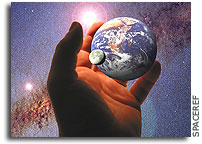NES Offers Web Seminars Through NSTA Learning Center

NASA Explorer Schools has teamed with the National Science Teachers Association, or NSTA, to offer Web seminars featuring NASA educational resources. Tech support is available during each of the Web seminars. To register, click on the link below each seminar description. If you do not already have a free Learning Center account, you will be prompted to create one.
Engineering Design Challenge: Spacecraft Structures — April 11, 2011, 6:30-8 p.m. EDT
In this challenge, students undertake the problem of designing a strong but lightweight thrust structure that can withstand the launch of a water bottle rocket by means of a wooden lever. Using simple materials, students strive to make their structure lighter while maintaining its strength and structural integrity. The scientific focus is on understanding forces, structures and energy transfer. http://learningcenter.nsta.org/products/symposia_seminars/NES/webseminar6.aspx
“Fingerprints of Life? Extremophiles: It’s Just Right” — April 20, 2011, 6:30-8 p.m. EDT
Organisms on Earth live in a wide range of environments. They live in hot boiling springs as well as in the ice of Antarctica. The microbes living in these extreme environments are called extremophiles. Some scientists are studying microbes that can live in Earth’s extreme environments to better understand places where life might have existed on other bodies in our solar system. http://learningcenter.nsta.org/products/symposia_seminars/NES/webseminar11.aspx
On the Moon Educators Guide: “On Target and Feel the Heat” — April 26, 2011, 6:30-8 p.m. EDT
NASA sent the Lunar CRater Observation and Sensing Satellite hurtling into a crater near the moon’s south pole to see if there’s water on the moon. The collision sent up a plume of dust and gas over 10 kilometers (6 miles) high. Scientists studied this plume to see if they could detect any signs of water in it. The success of LCROSS depended on hitting the crater exactly. http://learningcenter.nsta.org/products/symposia_seminars/NES/webseminar9.aspx
Satellite Meteorology: Monitoring the Global Environment — May 9, 2011, 6:30-8 p.m. EDT
The Satellite Meteorology Web seminar features “Monitoring the Global Environment,” one of eight modules within the Satellite Meteorology course. The activities within this module incorporate the use of authentic data taken from satellites in NASA’s GOES (Geostationary Operational, Environmental, Satellites) and POES (Polar Operational, Environmental, Satellites) program. http://learningcenter.nsta.org/products/symposia_seminars/NES/webseminar10.aspx
Earth Climate Course — May 17, 2011, 6:30-8 p.m. EDT
In this Web seminar, you will learn the answer to the question, “What factors have the greatest influence on the temperature of a planet?” The featured lesson is “Modeling Hot and Cold Planets” from the educator guide, where students design an experiment to determine the factors having the greatest influence on the temperature of a planet. Students test their hypotheses using physical and computer models. http://learningcenter.nsta.org/products/symposia_seminars/NES/webseminar2.aspx
The Virtual Lab — May 25, 2011, 6:30-8 p.m. EDT
This Web seminar focuses on using a free, downloadable computer program that simulates a scanning electron microscope. Selected specimens from life sciences, physical sciences, and Earth and space sciences related to current NASA research will be featured. With this virtual tool, your students have access to high-powered simulated scientific instrumentation with 90 different specimens and three different virtual tools: atomic force microscope, scanning electron microscope and fluorescence light microscope. http://learningcenter.nsta.org/products/symposia_seminars/NES/webseminar7.aspx
Please email any questions about these Web seminars to webseminars@nsta.org.








